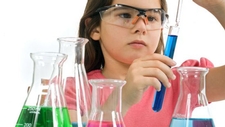Comparing Mixtures and Solutions

TEKS Objective
The student is expected to compare and contrast a variety of mixtures and solutions such as rocks in sand, sand in water, or sugar in water.
Essential Understanding
The student knows that matter has physical properties and those properties determine how matter is classified, changed and used.
Science Background
An Introduction to Chemical Mixtures: BioEd Online (video) - Dr. Dave Caprette describes mixtures and solutions, with examples.
An Introduction to Chemical Mixtures
by Dave Caprette, BioEd Online, www.bioedonline.org
What are Mixtures and Solutions? Virtual Chembook, Elmhurst College (website) - Overview of mixtures and solutions.
Mixtures: Virtual Education (website) - Short page with straightforward explanations of mixtures, solutions, suspensions and colloids.
Mixtures
Virtual Education, www.virted.org
Solutions and Mixtures: Chem4Kids (website) - Basic information about solutions and mixtures, with clear illustrations and descriptions that aid in understanding the content being presented.
Signature Lesson
What Dissolves in Water? BioEd Online (video and website) – Students investigate a variety of mixtures and solutions.
What Dissolves in Water? Related Video
BioEd Online, www.bioedonline.org
What Dissolves in Water? View and download the Activity
BioEd Online, www.bioedonline.org
- Supporting Lessons
- Extensions
- Assessment Ideas
- Literature Connections
- Related
TEKS - Additional Resources
Supporting Lessons
Separating a Mixture: Perkins School for the Blind (website) - Students use various methods to separate salt from sand.
Separating a Mixture
Perkins School for the Blind, www.perkins.org
Separating Mixtures: Discovery Education (website) - Students use chromatography to separate and analyze ink mixtures from a variety of pens.
Separating Mixtures
Discovery Education, www.school.discoveryeducation.com
Properties of Mixtures and Solutions: University of Virginia (website) - Students make observations, organize and analyze information, and measure and record data while identifying, separating and determining the concentrations of components in mixtures.
Properties of Mixtures and Solutions
University of Virginia, http://galileo.phys.virginia.edu
Separation of a Mixture: Alabama Learning Exchange (website) - Students explore mixtures, recognize that a mixture is created when two or more materials are combined, and design their own procedures for separating a mixture of four ingredients.
Separation of a Mixture
Alabama Learning Exchange, http://alex.state.al.us
Elaboration Lessons and Extensions
Separating Mixtures: TeachEngineering (website) – Advanced content on mixtures and solutions with suggestions for additional activities.
Separating Mixtures
TeachEngineering, www.teachengineering.org
Mixtures and Solutions Lesson Plans, Worksheets, Printables: Plan It (website) Search Plan It allows you to find lessons and other resources on the area of physical science.
Mixtures and Solutions Lesson Plans, Worksheets, Printables
Search Plan It, www.searchplanit.com
Assessment Ideas
Give students a variety of sample substances (e.g., sand and sugar mixed together, carbonated beverage, piece of concrete, salt). Ask them to identify the samples that represent a mixture and to explain their answers. [Pure salt is not a mixture; all the other examples are.] Then, have students identify the mixtures that are solutions. [The carbonated beverage, “soda,” is an example of a solution.]
Literature Connections
Mix It Up! Solution or Mixture? Nelson, Tracy (ISBN-13: 978-1618102270)
Matter. Cooper, Christopher (ISBN-13: 978-0751361353)
Salt. Walpole, Brenda (ISBN-13: 978-1560740605)
Iron. Hasan, Heather (ISBN-13: 978-1404201576)
Mixtures and Solutions: Why Chemistry Matters. Aloian, M. (ISBN-13: 978-0778742500)
Mixtures and Solutions: Reading Essentials in Science. Karpelenia, J. (ISBN-10: 0756946425)
Additional Resources
Mixtures and Solutions: Science-class.net (website) - Links to activity labs, quizzes, sideshows, and other resources to help you present and teach concepts related to mixtures and solutions.
TEKS Navigation
Grade 4
Need Assistance?
If you need help or have a question please use the links below to help resolve your problem.

Comments